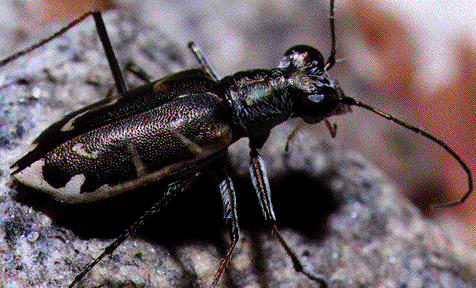 |
| Image from University of Connecticut |
The Puritan Tiger Beetle (Cicindela puritana) was found on the United States endangered species list, and I couldn’t find why it was so puritanical, though it may simply refer to its New England upbringing (just a guess). The “tiger beetle” part of the name is much easier to place, as it (and others of its family) is a ferocious predator, hunting smaller insects. By virtue of their good eyesight and bursts of speed, the beetles are frequently successful. They inhabit the beaches along the Connecticut River in Connecticut and Massachusetts2.
They, or at least the males, have an interesting mating strategy. While the actual copulation only lasts a few minutes, the males will mount the females for up to six hours at a time. This is to ensure that their sperm is the one that fertilizes the eggs3. I’m pretty sure I’ve heard of this strategy with other animals, but it’s certainly an interesting one. The only problem with that strategy is that it means that the beetle is occupied for about six hours. Beachgoers to the Connecticut River thus have a high likelihood of disrupting their… "relationships." The little larvae live for two years in holes in the sand, grabbing prey that wanders too close to the air hole. Other threats to this little predator include dams (of course), habitat loss, and people walking over the grubs’ burrows.
The Connecticut Department of Environmental Protection is working hard to make sure people know about the Puritan Tiger Beetle’s plight, putting up signs, sending out flyers, and generally trying to keep people from coleopteran coitus interruptus.
1I’m looking at you, Rheopelopia acra.
2Of course! The two states that I simply can’t spell!
3This voids some ideas as to why they’re called Puritan Tiger Beetles.

1 comment:
Wow, that insect is really interesting. Thank you for taking the time to write nice stuff like this. I enjoyed reading it so much.
Post a Comment